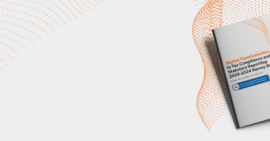Freeing up time to focus on business growth is a key goal for any C-level executive. Chief Information Officers (CIOs) regularly face significant pressure to meet deadlines, solve strategic concerns and keep up with demands generated from every level of the organisation.
During the pandemic we witnessed an accelerated transformation towards digitisation. The role of the CIO consequently garnered more influence and visibility in these last two years, evolving beyond the scope of core IT responsibilities.
In order to keep up, CIOs must upgrade their IT systems and prepare their organisation for operational excellence. Introducing automation within the tax function of an organisation allows CIOs to be less dependent on manual tasks in their role, making way for more strategic thinking.
We take a look at the top three areas today’s technology leaders are focussing on to create more efficient operations in 2022 and beyond.
Automating Indirect Tax
Indirect tax is a complex area and organisations need to keep up with compliance, legislation and the updated rules and regulations provided by tax authorities. With increased tax authority focus on transactional taxes such as indirect tax and VAT, multiple legacy systems and manual/excel driven processes can overwhelm resources by having to keep this updated, in both the finance function and the technology department. To ease this burden, CIOs are prioritising automation by increasing their use of technology-driven compliance.
Companies will be required to work more closely with their tax department than ever before, to allow for real time filing. This means aligning their chosen technology solution with the tax authority’s compliance initiatives to future-proof the indirect tax team. The implications of non-compliance are not limited to increased costs, liability and reputational damage but can impact profitability and the business overall.
Indirect taxes are calculated on a transaction-by-transaction basis but as the volume of data continues to increase comes a need for a new way to calculate tax effectively.
The benefits of investing in indirect tax technology include:
- Getting accurate indirect tax rates
- Improved indirect tax compliance
- Reduced indirect tax errors, overpayments and fees
- Refocused resource dedicated to manual indirect tax tasks
- Reduced risk of tax audits, penalties, assessments and interest
Data Security
As cybercrime continues to surge, with fraud and scams occurring daily, one of the top challenges facing organisations is information security.
Data and services continue to transition and expand to cloud platforms, attack touchpoints are also growing, creating a more complex organisational perimeter for CIOs to secure. With the ongoing hybrid working model and people continuing to work across multiple devices, access to sensitive information is more readily available.
These mounting vulnerability points need to be addressed with new tools and strategies for visibility and defense. A Gartner survey of over two thousand CIOs, revealed that cyber and information security is at the top of the list of investments for 2022. More than three in five (66%) of all CIO respondents expect to increase associated investments in the next year.
One of the main benefits of automating the tax process is to share data across systems to improve productivity, gain insights and create a single source of truth, which is achieved through ERP integration. However, CIOs need to ensure they are protecting their servers and mitigate their IT risks by choosing secure web APIs and embedding mature processes that address the constantly evolving regulatory landscape with governance frameworks.
Talent Reimagined
With automation and digitisation on the rise, organisations are seeking to evolve in a variety of business sectors, including reshaping the role of the tax and finance functions. One key challenge hindering this potential growth is attracting and retaining top talent. A 2022 KPMG report revealed key concerns of over 400 business leaders, and talent acquisition, retention, and re/upskilling to meet a more digitised future was overwhelming seen as the biggest challenge for the year ahead, with 69% nominating this issue.
Increased transparency in tax legislation and regulatory reforms has made it essential for organisation’s to attract top tier professionals with a profound understanding of how to work within this face-paced dynamic environment. Not having the right people in place puts pressure on how fast a company can accelerate, regardless of strategic priorities or budget.
In order to remain competitive, enhancing an employee’s core skill set beyond technical reporting is becoming just as important. A deep understanding of data analytics, technology transformation and data governance empowers the employee to become an asset in identifying, evaluating and responding to changing tax laws and regulations.
As the increased pressure on tax talent is expected to significantly grow, CIOs must also consider that to fully make their business model work as efficiently as possible their needs be a balance between finding the correct talent and investing in automation by leaning on specialised tax technology solution providers.
Conclusion
Organisations by nature are ever-changing and this has been exacerbated by the increased pressure due to the rise of digitisation. How does a CIO navigate this accelerated uncharted landscape? In short, it’s with scenario planning.
With the new hybrid working model here to stay, now is the right time for organisations to develop an effective and strategic roadmap to handle emerging issues. The CIO must reimagine the way they approach tax functions and look to invest in attracting and maintaining the correct tax talent to exceed the business needs of today and beyond.
For more information on investing in the right tax software can ensure confidence in building the foundation of your organisations tax compliancy and credibility, speak with a Thomson Reuters specialist today.


